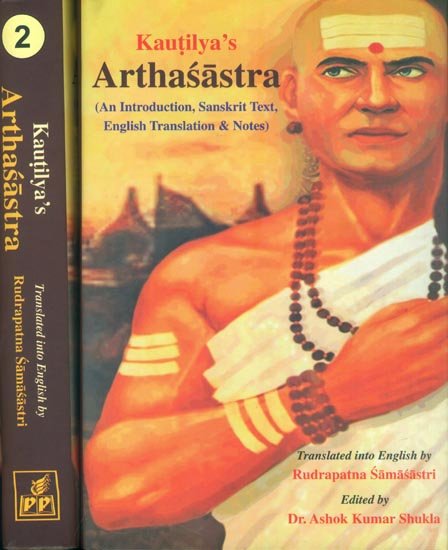Kautilya Arthashastra
by R. Shamasastry | 1956 | 174,809 words | ISBN-13: 9788171106417
The English translation of Arthashastra, which ascribes itself to the famous Brahman Kautilya (also named Vishnugupta and Chanakya) and dates from the period 321-296 B.C. The topics of the text include internal and foreign affairs, civil, military, commercial, fiscal, judicial, tables of weights, measures of length and divisions of time. Original ...
Chapter 2 - Determination of the Place of Ānvīkṣakī
[Sanskrit text for this chapter is available]
Summary: The End of Sciences (a): Determination of the Place of Ānvīkṣakī.
Ānvīkṣakī,[1] the triple Vedas (Trayī), Vārtā[2] (agriculture, cattle-breeding and trade), and Daṇḍa-Nīti (science of government) are what are called the four sciences.
The school of Manu (Mānava) hold that there are only three sciences: the triple Vedas, Vārtā and the science of government, inasmuch as the science of Ānvīkṣakī is nothing but a special branch of the Vedas.
The school of Bṛhaspati say that there are only two sciences: Vārtā and the science of government, inasmuch as the triple Vedas are merely an abridgment (Saṃvaraṇa, pretext?) for a man experienced in affairs temporal (Lokayātrāvida).
The school of Uśanas declare that there is only one science, and that the science of government; for, they say, it is in that science that all other sciences have their origin and end.
But Kauṭilya holds that four, and only four, are the sciences; wherefore it is from these sciences that all that concerns righteousness and wealth is learnt, therefore they are so called.
Ānvīkṣakī comprises the Philosophy of Sāṅkhya, Yoga, and Lokāyata (Atheism?).
Righteous and unrighteous acts[3] (Dharmādharmau) are learnt from the triple Vedas; wealth and non-wealth from Vārtā; the expedient and the inexpedient (Nayānayau), as well as potency [7] and impotency (Balābale) from the science of government.
When seen in the light of these sciences, the science of Ānvīkṣakī is most beneficial to the world, keeps the mind steady and firm in weal and woe alike, and bestows excellence of foresight, speech and action.
Light[4] to all kinds of knowledge, easy means to accomplish all kinds of acts and receptacle of all kinds of virtues, is the Science of Ānvīkṣakī ever held to be.[5]
[Thus ends Chapter II, “Determination of the Place of Ānvīkṣakī” among Sciences, in Book I, “Concerning Discipline” of the Arthaśāstra of Kauṭilya.]
Footnotes and references:
[1]:
See below.
[2]:
See Chapter IV, Book I.
[3]:
Mallinātha quotes this passage in his commentary on stanza 50, Canto XVIII, of Raghuvamśa.
[4]:
In śloka metre.
[5]:
Ka. II, 1-9.
